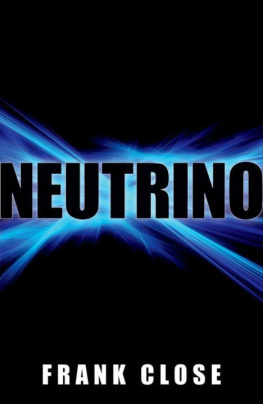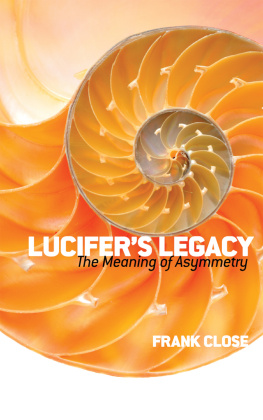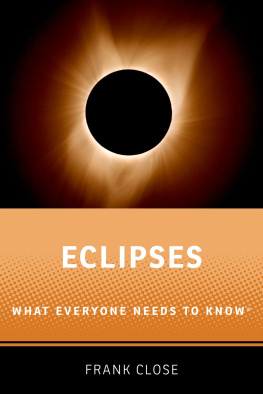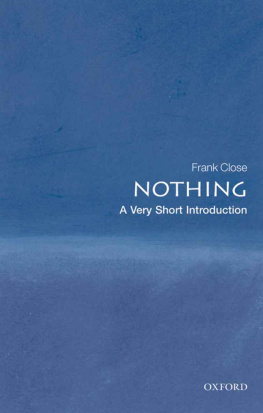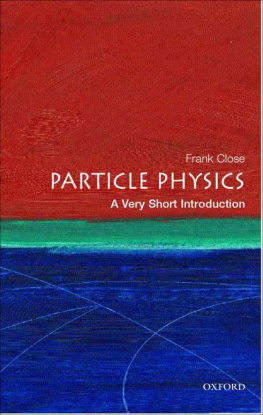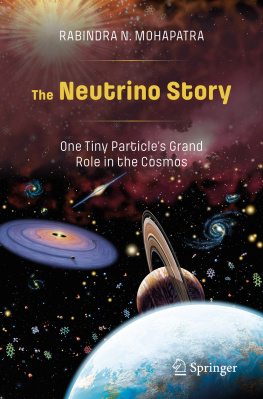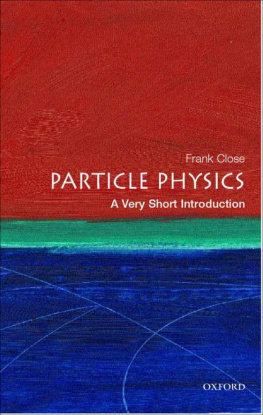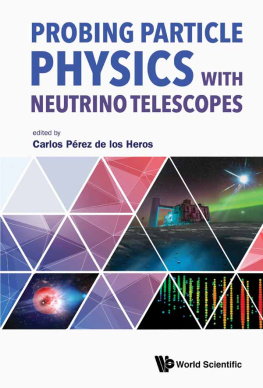Frank Close - Neutrino
Here you can read online Frank Close - Neutrino full text of the book (entire story) in english for free. Download pdf and epub, get meaning, cover and reviews about this ebook. genre: Science fiction. Description of the work, (preface) as well as reviews are available. Best literature library LitArk.com created for fans of good reading and offers a wide selection of genres:
Romance novel
Science fiction
Adventure
Detective
Science
History
Home and family
Prose
Art
Politics
Computer
Non-fiction
Religion
Business
Children
Humor
Choose a favorite category and find really read worthwhile books. Enjoy immersion in the world of imagination, feel the emotions of the characters or learn something new for yourself, make an fascinating discovery.
- Book:Neutrino
- Author:
- Genre:
- Rating:5 / 5
- Favourites:Add to favourites
- Your mark:
- 100
- 1
- 2
- 3
- 4
- 5
Neutrino: summary, description and annotation
We offer to read an annotation, description, summary or preface (depends on what the author of the book "Neutrino" wrote himself). If you haven't found the necessary information about the book — write in the comments, we will try to find it.
Neutrino — read online for free the complete book (whole text) full work
Below is the text of the book, divided by pages. System saving the place of the last page read, allows you to conveniently read the book "Neutrino" online for free, without having to search again every time where you left off. Put a bookmark, and you can go to the page where you finished reading at any time.
Font size:
Interval:
Bookmark:




FRANK CLOSE

vii
ix

With X-rays, which penetrate much more than ordinary light, you can see inside your hand. With neutrinos, which penetrate much more even than X-rays, you can look inside the Sun.
(Nobel Ceremony 2002)
Ray Davis was the first person to look into the heart of a star. He did so by capturing neutrinos, ghostly particles that are produced in the centre of the Sun and stream out across space. As you read this, billions of them are hurtling, unseen, through your eyeballs at almost the speed of light.
Neutrinos are as near to nothing as anything we know, and are so elusive that they are almost invisible. When Davis began looking for solar neutrinos, in 1960, many thought that he was attempting the impossible. It nearly turned out to be so: 40 years were to pass before he was proved right, leading to his Nobel Prize for physics in 2002, aged 87.
Longevity is an asset in the neutrino business. Not everyone would be so fortunate.

In June 2006, I was invited by The Guardian newspaper to write the obituary of Ray Davis. I was surprised and honoured when, the following year, the obituary won the prize for the `Best science writing in a non-scientific context'. A reason, I am sure, is that the story of Davis's remarkable career, in a sense, wrote itself.
An obituary necessarily focuses on the one person, but the saga of the solar neutrinos touched the lives of several others, scientists who devoted their entire careers to chasing this elusive quarry, only to miss out on a Nobel Prize by virtue of irony, chance or, more tragically, by having already died. For this quest spans half a century, Davis winning his Nobel at age 87. Of them all, the most tragic perhaps is the genius Bruno Pontecorvo. Although when I began writing Neutrino I anticipated that it would be the story of Ray Davis, I discovered that Pontecorvo seemed to be there behind the scenes to such an extent that this became his story too - and also the story of John Bahcall, Davis's lifelong collaborator who, to the surprise of many, was not included in the Nobel award. So I humbly dedicate this book to the memory of these three great scientists, whose own lives were testimony to what science is all about, and proof of Thomas Edison's assertion that genius is `1 per cent inspiration and 99 per cent perspiration'.
I am particularly indebted to four of my colleagues - whose own careers have been focused on neutrinos -for providing some of their own memories, and for correcting some of my misconceptions. If I have not succeeded, the fault is mine, not theirs: Nick Jelley, Peter Litchfield, Don Perkins and Jack Steinberger.



Of all the things that make the universe, the commonest and weirdest are neutrinos. Able to travel through the earth like a bullet through a bank of fog, they are so shy that half a century after their discovery we still know less about them than all the other varieties of matter that have ever been seen.
Some of these will-o'-the-wisps are coming up from the ground beneath our feet, emitted by natural radioactivity in rocks, and some are the result of radioactivity in our own bodies, but most of those hereabouts were born in the heart of the Sun, less than 10 minutes ago. In just a few seconds, the Sun has emitted more neutrinos than there are grains of sand in the deserts and beaches of the world, greater even than the number of atoms in all the humans that have ever lived. They are harmless: life has evolved within this storm of neutrinos.
Neutrinos can pass through the Sun almost as easily as through the earth. Within a few seconds of being born in the heart of the Sun, these hordes have escaped from the surface and poured into space. If we could see with neutrino eyes, night would be as bright as day: neutrinos from the Sun shine down on our heads by day and up through our beds by night, undimmed.
Not just the Sun but each of the stars visible to the naked eye, and the countless ones seen by the most powerful telescopes, are all filling the void with neutrinos. Out in space, away from the Sun and stars, the universe is flooded by them.
Even you are producing them. Traces of radioactivity from potassium and calcium in your bones and teeth produce neutrinos. So, as you read this, you are irradiating the universe.
All in all, there are more neutrinos than any other particle we know, certainly far more than the electrons and protons that make the stars and all visible matter such as you and me. Once, they were thought to have no mass and to travel at the speed of light; today we know that they do have a little mass, though so trifling that no one has yet measured it. All we know is that if you had some subatomic scales, it would take at least 100,000 neutrinos to balance a single electron. Even so, their vast numbers make it possible that, in total, they outweigh all the visible matter of the universe.
The neutrinos from the Sun that have poured through you since you started reading this are already speeding onwards beyond Mars. A few hours from now they will cross the distant boundaries of the Solar System and head out into the boundless cosmos. If you were a neutrino, the chances are that you would be immortal, never bumping into atoms in billions of years.
Were you to ask a neutrino in the depths of space about its history, it is likely that it would turn out to be as old as the universe. The neutrinos born in the Sun and stars, numerous though they are, are relative newcomers. Most are fossil relics of the Big Bang, and have been travelling through space unseen for over 13 billion years.
Neutrinos are passing through our universe like mere spectators, as if we were not here. They are so shy that it is remarkable that we know that they exist at all. How did these ghostly, invisible pieces of nothingness give themselves away? Why does nature need them? What use are they?
Nature hides its secrets deep, but there are clues; it's a matter of being prepared to notice and act on them. Five billion years ago, as the cocktail of elements from a supernova solidified into the rocks of the newborn Earth, radioactive atoms were trapped there. Radioactivity occurs when the nuclei of atoms spontaneously change form: granite is not forever the same. For as long as the earth has existed, atoms of uranium and thorium, frozen into the minerals of its crust, have been eroding, transmuting into lighter elements, cascading down the periodic table until they have changed into stable atoms of lead. It is in this natural chronometer of radioactivity that neutrinos are born. That is where our story begins.
Font size:
Interval:
Bookmark:
Similar books «Neutrino»
Look at similar books to Neutrino. We have selected literature similar in name and meaning in the hope of providing readers with more options to find new, interesting, not yet read works.
Discussion, reviews of the book Neutrino and just readers' own opinions. Leave your comments, write what you think about the work, its meaning or the main characters. Specify what exactly you liked and what you didn't like, and why you think so.

